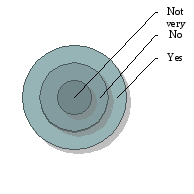- Учителю
- Исследовательская работа Fast Food-it healthy or poisonous?
Исследовательская работа Fast Food-it healthy or poisonous?
Государственное учреждение образования
«Средняя школа №10 г.Витебска»
Fast Food-it healthy or poisonous?
Информационный проект
Рукавицына Татьяна
Николаевна
10 «А» класс
Ревзина-Титова Александра
Геннадьевна
учитель английского языка
II-й категории
Витебск-2014
Contents
Introduction
Part I. Theoretical foundations of fast food
1. History of the emergence of fast food
2. Representatives of fast food
2.1 Pop corn
2.1.1 History
2.1.2 Health risks
2.2. Hot dog
2.2.1 History
2.2.2 Etymology
2.2.3 Health effects
2.2.4 Choking risk
2.3. Hamburger
2.3.1 History
2.3.2 Etymology
2.3.3 Health effects
2.4. Coca-Cola
2.4.1 History
2.4.2 Health effects
3. Fast food restaurants.
3.1 The reasons of popularity
4. Impact of fast food on human health
Part II. Practical part
1.Research.
2.Experiments
2.1 Experiments with Fanta, Coke and plan water.
2.2 Experiments with Coca-cola and humbug
2.2. Experimants with crisps
VII. Conclusion.
VIII. List of literature.
Introduction
Crazy pace of life leaves no room for modern man to dine slowly, with pleasure. So to lay the collar starched napkin and enjoy with pleasure first, second and third. Instead thorough meal has to be content with food in a hurry in the range of a business lunch in the nearest eatery to an instant noodle in a bag, hamburger or hotdog. "Fast food" has long been a part of the modern world.
Today in our city you can eat at every turn. In many places set pavilions, where they sell hot sausage rolls, pancakes, sandwiches. There are all kinds of cafeterias, cafes. In general, do not stay hungry.
Modern society relies heavily on fast food. However, we are not able to understand the fact that there are certain problems that are associated with the consumption of fast food.
Fast food is the term given to food that can be prepared and served very quickly, first popularized in the 1950s in the United States. While any meal with low preparation time can be considered to be fast food, typically the term refers to food sold in a restaurant or store with preheated or precooked ingredients, and served to the customer in a packaged form for take-out.
Fast food chains have come under criticism over concerns ranging from claimed negative health effects, alleged animal cruelty, cases of worker exploitation, and claims of cultural degradation via shifts in people's eating patterns away from traditional foods
Based on the huge number of different opinions, we decided to
investigate this issue and answer the question: fast-food-harm or
benefit?
The aim of my work is to prove that fast food has only cons.
The tasks are to get and analyze information about history of fast
food and popular fast food restaurants, to determine pros and cons
of fast food, to find out
why fast food is so popular.
Hypothesis: fast food is so popular all over the world so it can't
be harmful for people. If it's true?
Object: Fast food.
Subject: Its influence of man's health.
Methods of research: - studying information
- analysis
- determination
- classification
Part 1. Theoretical foundations of fast food
1. History of the emergence of fast food
Most people think the McDonald brothers of California started the fast-food craze in America, but in reality, it was the White Castle hamburger chain that actually started fast food history in America. J. Walter Anderson opened the first White Castle in 1916 in Wichita, Kansas, and people liked the cheap hamburgers, fries, and colas he offered. However, fast-food really didn't become common in America until after World War II, when Americans first began to fall in love with their cars, and had leisure time and more money to spend on eating out.
The real heroes of fast food history in America are Richard and Maurice McDonald, the two brothers who created the first McDonald's restaurant in 1948 in San Bernardino, California. They wanted their restaurant to be more efficient and cost-effective, so they designed a simple menu in a small building without any tables, so people took their food and ate in their cars. By 1953, the brothers had decided to franchise their idea, and two franchises opened in Downey, California and Phoenix, Arizona.
As the McDonald's became more successful, others began to take notice and copy their example to make their own fast food history in America. Keith Cramer started an operation in Florida that would turn into Burger King, and Ray Kroc, a blender salesman, was so impressed with McDonald's that he asked the brothers if he could sell their franchises. He opened his own McDonald's in Des Plaines, Illinois in 1954, and eventually he bought out the brothers and became the owner of the corporation. Kroc was the driving force behind the food chain's fantastic growth throughout America in the late 50s and early 60s. Wendy's was created by Dave Thomas in Columbus, Ohio, where the first restaurant opened in 1962.
As fast food caught on, and more people decided they liked dining in their cars; more fast food shops sprang up around the country. Jack-in-the-Box began in San Diego, California in 1951, and by 1960 it had spread out of California into other areas. Troy Smith opened the first SONIC Drive-In in 1954 in Shawnee, Oklahoma, Dunkin' Donuts first opened in Quincy, Massachusetts in 1950, and the first Taco Bell opened in 1962 in Downey, California. All of these operations based their business at least loosely on the McDonald's operation and then modified it to work with their specialty foods.
Today, fast food chains have spread all around the world, and have spread American culture right along with them. There are many more popular chains, like Carl's Jr., Arby's, Domino's and Dairy Queen, indicating that fast food isn't always about hamburgers. In fact, pizza, Chinese food, and just about any type of food imaginable are now available for take-out at fast-food chains across the globe. Fast food history in America is really the foundation of fast food as we know it today, and that history has made millionaires out of many of the people who first stated the fast food concept.
2. Representatives of fast food
2.1 Pop corn
Popcorn, also known as popping corn, is a type of corn that expands from the kernel and puffs up when heated. Popcorn is able to pop because, like amaranth grain, sorghum, quinoa, and millet, its kernels have a hard moisture-sealed hull and a dense starchyinterior. Pressure builds inside the kernel, and a small explosion (or "pop") is the end result. Some strains of corn are now cultivated specifically as popping corns. There are various techniques for popping corn. Along with prepackaged popcorn, which is generally intended to be prepared in a microwave oven, there are small home appliances for popping corn. These methods require the use of minimally processed popping corn. A larger-scale, commercial popcorn machine was invented by Charles Cretors in the late 19th century. Unpopped popcorn is considered nonperishable and will last indefinitely if stored in ideal conditions. Depending on how it is prepared and cooked, some consider popcorn to be a health food, while others caution against it for a variety of reasons. Popcorn can also have non-food applications, ranging from holiday decorations to packaging materials.
2.1.1 History
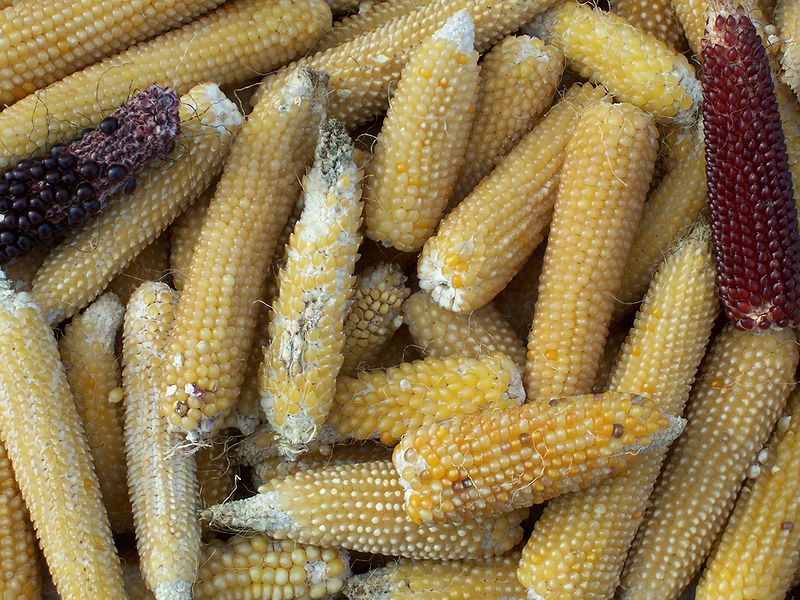 Popcorn
was first cultivated thousands of years ago by the people living in
what is now Peru. It is one of the oldest forms of corn; evidence
of popcorn from 3600 B.C. was found in New Mexico, while even older
evidence was found in Peru. It is estimated that these remnants
date from as early as 4700 B.C. Purple popcorn was found in the
early 1900s.
Popcorn
was first cultivated thousands of years ago by the people living in
what is now Peru. It is one of the oldest forms of corn; evidence
of popcorn from 3600 B.C. was found in New Mexico, while even older
evidence was found in Peru. It is estimated that these remnants
date from as early as 4700 B.C. Purple popcorn was found in the
early 1900s.
The legend that English settlers, who came to America in the 16th and 17th centuries, learned about popcorn from American Indians has been proven to be a myth. No evidence exists from colonial times to support the claim that natives of North America's east coast even knew of, or, for that matter, grew popcorn.
During the Great Depression, popcorn was fairly inexpensive at 5-10 cents a bag and became popular. Thus, while other businesses failed, the popcorn business thrived and became a source of income for many struggling farmers. During World War II, sugar rations diminished candy production, and Americans compensated by eating three times as much popcorn as they had before.
At least six localities (all in the Midwestern United States) claim to be the "Popcorn Capital of the World": Ridgway, Illinois; Valparaiso, Indiana; Van Buren, Indiana; Schaller, Iowa; Marion, Ohio; and North Loup, Nebraska. According to the USDA, corn used for popcorn production is specifically planted for this purpose; most is grown in Nebraska and Indiana, with increasing area inTexas.
As the result of an elementary school project, popcorn became the official state snack food of Illinois.
2.1.2 Health risks
Popcorn is included on the list of foods that the American Academy of Pediatrics recommends not serving to children under four, because of the risk of choking.
Microwaveable popcorn represents a special case, since it is designed to be cooked along with its various flavoring agents. One of these common artificial-butter flavorants, diacetyl, has been implicated in causing respiratory illnesses.
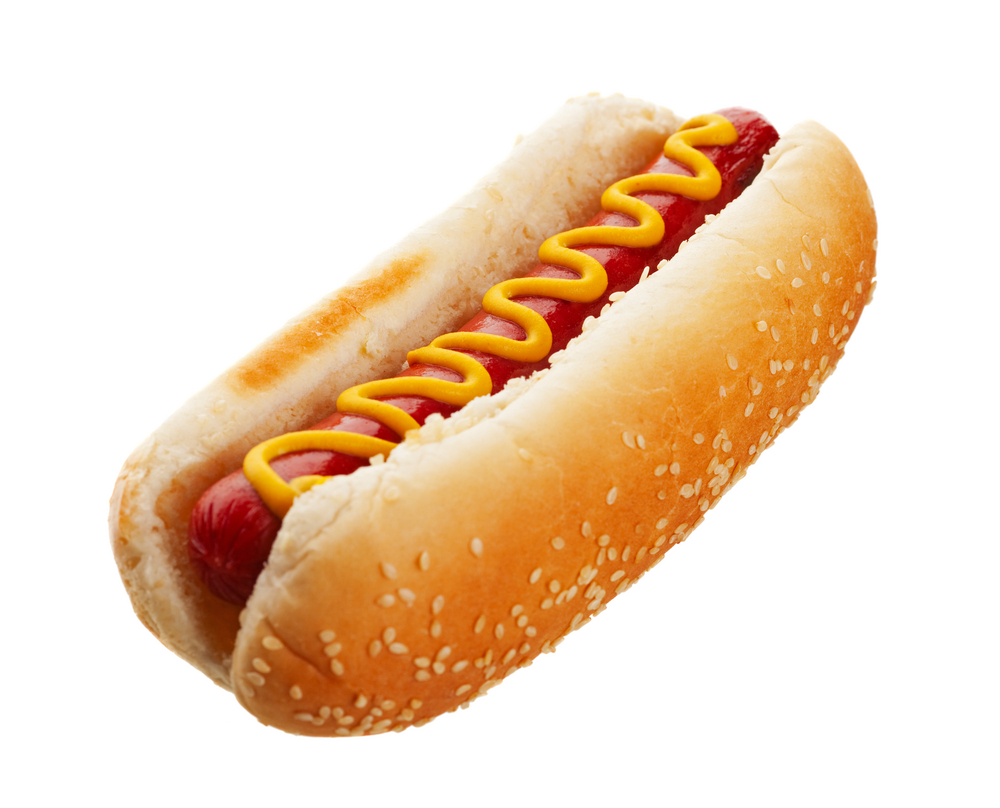
2.2. Hot dog
A hot dog is a cooked sausage, traditionally grilled or steamed and served in a sliced bun as a sandwich. Hot dog variants include the corn dogdipped in corn batter and deep fried, pigs in blankets wrapped in dough, baked, and served as hors d'oeuvres, and Beanie Weenies chopped and mixed with baked beans. Typical hot dog garnishes include mustard, ketchup, onions, mayonnaise, relish, cheese, chili, and sauerkraut.
The sausages were culturally imported from Germany and popularized in the United States, where they were a working class street food sold at hot dog stands that came to be associated with baseball and America. Hot dog preparation and condiment styles also vary regionally across the United States. The hot dog's cultural traditions include the Nathan's Hot Dog Eating Contest and Wienermobile.
2.2.1History
Claims about hot dog invention are difficult to assess, as stories
assert the creation of the sausage, the placing of the sausage (or
another kind of sausage) on bread or a bun as finger food, the
popularization of the existing dish, or the application of the name
"hot dog" to a sausage and bun combination most commonly used with
ketchup or mustard and sometimes relish.
The word frankfurter comes from Frankfurt, Germany, where pork sausages similar to hot dogs originated. These sausages, Frankfurter Würstchen, were known since the 13th century and given to the people on the event of imperial coronations, starting with the coronation of Maximilian II, Holy Roman Emperor as King. Wiener refers to Vienna, Austria, whose German name is "Wien", home to a sausage made of a mixture of pork and beef (cf. Hamburger, whose name also derives from a German-speaking city). Johann Georg Lahner, a 18th/19th century butcher from the Franconian city of Coburg, is said to have brought the Frankfurter Würstchen to Vienna, where he added beef to the mixture and simply called it Frankfurter. Nowadays, in German speaking countries, except Austria, hot dog sausages are called Wiener or Wiener Würstchen (Würstchen means "little sausage"), in differentiation to the original pork only mixture from Frankfurt. In Swiss German, it is called Wienerli, while in Austria the terms Frankfurter or Frankfurter Würstel are used.
Around 1870, on Coney Island, German immigrant Charles Feltman began selling sausages in rolls.
C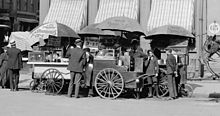 arts
selling frankfurters in New York City, circa 1906. The price is
listed as "3 cents each or 2 for 5 cents".
arts
selling frankfurters in New York City, circa 1906. The price is
listed as "3 cents each or 2 for 5 cents".
Others have supposedly invented the hot dog. The idea of a hot dog on a bun is ascribed to the wife of a German named Antonoine Feuchtwanger, who sold hot dogs on the streets of St. Louis, Missouri, United States, in 1880, because his customers kept taking the white gloves handed to them for eating without burning their hands. Anton Ludwig Feuchtwanger, a Bavarian sausage seller, is said to have served sausages in rolls at the World's Fair-either the 1893 World's Columbian Exposition in Chicago or the 1904 Louisiana Purchase Exposition in St Louis-again allegedly because the white gloves he gave to customers so that they could eat his hot sausages in comfort began to disappear as souvenirs.
The association between hot dogs and baseball began as early as 1893 with Chris von der Ahe, a German immigrant who owned not only the St. Louis Browns, but also an amusement park.
Another claim of inventing the hot dog is told by Harry M. Stevens, an American sports concessionaire whose vendors sold German sausages and rolls to spectators at the old New York Polo Grounds during the winter. He called them "Dachshund sandwiches", but a New York Post cartoonist "couldn't spell dachshund, so when he drew the cartoon, he called them hot dogs."
In 1916, a Polish American employee of Feltman's named Nathan Handwerker was encouraged by Eddie Cantor and Jimmy Durante, both working as waiters/musicians, to go into business in competition with his former employer. Handwerker undercut Feltman's by charging five cents for a hot dog when his former employer was charging ten.
At an earlier time in food regulation, when the hot dog was suspect, Handwerker made sure that men wearing surgeon's smocks were seen eating at Nathan's Famous to reassure potential customers.
2.2.2 Etymology
The term dog has been used as a synonym for sausage since 1884 and accusations that sausage makers used dog meat date to at least 1845. In the early 20th century, consumption of dog meat in Germany was common. The suspicion that sausages contained dog meat was "occasionally justified".
According to a myth, the use of the complete phrase hot dog in reference to sausage was coined by the newspaper cartoonist Thomas Aloysius "TAD" Dorgan around 1900 in a cartoon recording the sale of hot dogs during a New York Giants baseball game at the Polo Grounds. However, TAD's earliest usage of hot dog was not in reference to a baseball game at the Polo Grounds, but to a bicycle race at Madison Square Garden, in The New York Evening Journal December 12, 1906, by which time the term hot dog in reference to sausage was already in use. In addition, no copy of the apocryphal cartoon has ever been found.
The earliest known usage of hot dog in clear reference to sausage, found by Fred R. Shapiro, appeared in the December 31, 1892 issue of the Paterson (New Jersey) Daily Press. The story concerned a local traveling vendor, Thomas Francis Xavier Morris, also known as "Hot Dog Morris".
Somehow or other a frankfurter and a roll seem to go right to the spot where the void is felt the most. The small boy has got on such familiar terms with this sort of lunch that he now refers to it as "hot dog." "Hey, Mister, give me a hot dog quick," was the startling order that a rosy-cheeked gamin hurled at the man as a Press reporter stood close by last night. The "hot dog" was quickly inserted in a gash in a roll, a dash of mustard also splashed on to the "dog" with a piece of flat whittled stick, and the order was fulfilled.
2.2.3 Health effects
Unlike other sausages which may be sold uncooked, hot dogs are cooked before packaging. Hot dogs can be eaten without additional cooking, although they are usually warmed before serving. Because an unopened, packaged hot dog can have Listeria bacteria that cause listeriosis, it is safer to heat them, especially for pregnant women and those with suppressed immune systems.
An American Institute for Cancer Research report found that consuming one 50-gram serving of processed meat - about one hot dog - every day increases risk of colorectal cancer by 20 percent. The Cancer Project group filed a class-action lawsuit demanding warning labels on packages and at sporting events. Hot dogs are high in fat and salt and have preservatives sodium nitrate and nitrite, which are possible contributors to nitrate-containing chemicals believed to cause cancer. According to the AICR, the average risk of colorectal cancer is 5.8 percent, but 7 percent when a hot dog is consumed daily over years.
Hot dogs have relatively low heterocyclic amines (HCA) levels compared to other types of ready-to-eat meat products, because they are manufactured at low temperatures.
2.2.4 Choking risk
Hot dogs present a significant choking risk, especially for children. A study in the US found that 17% of food-related asphyxiations among children younger than 10 years of age were caused by hot dogs. Their size, shape and texture make them difficult to expel from the windpipe. This risk can be reduced by cutting a hot dog into small pieces or lengthwise strips before serving to young children. It is suggested that redesign of size, shape and texture would reduce the risk. One pediatric emergency doctor comments that a stuck hot dog is "almost impossible" to dislodge from a child's windpipe.
2.3. Hamburger
A hamburger (also called a beef burger, hamburger sandwich, burger or hamburg) is a sandwich consisting of one or more cooked patties ofground meat (usually beef) usually placed inside a sliced hamburger bun. Hamburgers are often served with lettuce, bacon, tomato, onion, pickles, cheese and condiments such as mustard, mayonnaise, ketchup and relish.
T he
term "burger" can also be applied to the meat patty on its own,
especially in the UK where the term "patty" is rarely used. The
term may be prefixed with the type of meat as in "turkey burger".
he
term "burger" can also be applied to the meat patty on its own,
especially in the UK where the term "patty" is rarely used. The
term may be prefixed with the type of meat as in "turkey burger".
2.3.1 History
The hamburger, a ground meat patty between two slices of bread, was first created in America in 1900 by Louis Lassen, a Danish immigrant, owner of Louis' Lunch in New Haven, Connecticut.]There have been rival claims by Charlie Nagreen, Frank and Charles Menches, Oscar Weber Bilby, and Fletcher David. White Castle traces the origin of the hamburger to Hamburg, Germany with its invention by Otto Kuase. However, it gained national recognition at the 1904 St. Louis World's Fair when the New York Tribune namelessly attributed the hamburger as, "the innovation of a food vendor on the pike". No conclusive claim has ever been made to end the dispute over the inventor of the hamburger with a variety of claims and evidence asserted since its creation.
Hamburgers are usually a feature of fast food restaurants. The hamburgers served in major fast food establishments are usually mass-produced in factories and frozen for delivery to the site. These hamburgers are thin and of uniform thickness, differing from the traditional American hamburger prepared in homes and conventional restaurants, which is thicker and prepared by hand from ground beef. Generally most American hamburgers are round, but some fast-food chains, such as Wendy's, sell square-cut hamburgers. Hamburgers in fast food restaurants are usually grilled on a flat-top, but some firms, such as Burger King, use a gas flame grilling process. At conventional American restaurants, hamburgers may be ordered "rare", but normally are served medium-well or well-done for food safety reasons. Fast food restaurants do not usually offer this option.
Some North American establishments offer a unique take on the hamburger beyond what is offered in fast food restaurants, using upscale ingredients such as sirloin or other steak along with a variety of different cheeses, toppings, and sauces. Some examples would be the Bobby's Burger Palace chain founded by well-known chef and Food Network star Bobby Flay. Hamburgers are often served as a fast dinner, picnic or party food, and are usually cooked outdoors on barbecue grills. Raw hamburger may contain harmful bacteria that can produce food-borne illness such as Escherichia coli O157:H7, due to the occasional initial improper preparation of the meat, so caution is needed during handling and cooking. Because of the potential for food-borne illness, the USDA recommends hamburgers be cooked to an internal temperature of 170 °F (80 °C). If cooked to this temperature, they are considered well-done.
2.3.2 Etymology
The term hamburger originally derives from Hamburg, Germany's second largest city, from which many people emigrated to the United States. In High German, Burg means fortified settlement or fortified refuge and is a widespread component of place names. Hamburger, in the German language, is thedemonym of Hamburg. Similar to frankfurter and wiener, names for other meat-based foods, being demonyms of the cities of Frankfurt and Vienna(Wien), respectively. The term "burger", a back-formation, is associated with many different types of sandwiches similar to a (ground meat) hamburger, using different meats, such as a buffalo burger, venison, kangaroo, turkey, elk, lamb, salmon burger or veggie burger.
2.3.3 Health effects
Whether you just want to taste a bite of raw hamburger or eat the whole patty raw, the microorganisms in raw hamburger can be very dangerous to your health. Eating raw hamburger places you at high risk for food poisoning, which can cause unpleasant symptoms and, in some cases, serious or fatal complications.
Bacteria
Raw hamburger often contains dangerous pathogenic bacteria, such as salmonella, Listeria monocytogenes, Escherichia coli O157:H7, Staphylococcus aureus and Campylobacter jejuni, the U.S. Department of Agriculture's Food Safety and Inspection Service warns. You cannot smell, taste or see these bacteria in raw hamburger meat. Bacteria that gives hamburger meat a bad odor or rotten appearance are called spoilage bacteria and rarely make you sick. Raw hamburger is more likely to harbor dangerous bacteria than other types of meat because grinding beef exposes more of the meat to bacteria.
Food Poisoning
Pathogenic bacteria in raw hamburger meat can give you food poisoning. Food poisoning is characterized by nausea, vomiting, abdominal cramps, diarrhea, fever and dehydration. Some bacteria also cause other symptoms. For example, E. coli O157:H7, a bacteria found in raw hamburger, causes hemolytic uremic syndrome, which is fatal in 3 to 5 percent of cases, according to the National Digestive Diseases Information Clearinghouse. About 5,000 people in the United States die every year from food poisoning.

2.4. Coca-Cola
Coca-Cola is a carbonated soft drink sold in stores, restaurants, and vending machines throughout the world. It is produced by The Coca-Cola Company of Atlanta, Georgia, and is often referred to simply as Coke (a registered trademark of The Coca-Cola Company in the United States since March 27, 1944). Originally intended as a patent medicine when it was invented in the late 19th century by John Pemberton, Coca-Cola was bought out by businessman Asa Griggs Candler, whose marketing tactics led Coke to its dominance of the world soft-drink market throughout the 20th century.
The company produces concentrate, which is then sold to licensed Coca-Cola bottlers throughout the world. The bottlers, who hold territorially exclusive contracts with the company, produce finished product in cans and bottles from the concentrate in combination with filtered water and sweeteners. The bottlers then sell, distribute and merchandise Coca-Cola to retail stores and vending machines. The Coca-Cola Company also sells concentrate for soda fountains to major restaurants and food service distributors.
The Coca-Cola Company has, on occasion,
introduced other cola drinks under the Coke brand name. The most
common of these is Diet Coke, with others including Caffeine-Free
Coca-Cola, Diet Coke Caffeine-Free, Coca-Cola Cherry, Coca-Cola
Zero, Coca-Cola Vanilla, and special versions with lemon, lime or
coffee.
2.4.1 History
Colonel John Pemberton was wounded in the Civil War, became addicted to morphine, and began a quest to find a substitute to the dangerous opiate.The prototype Coca-Cola recipe was formulated at Pemberton's Eagle Drug and Chemical House, a drugstore in Columbus, Georgia, originally as a coca wine. He may have been inspired by the formidable success of Vin Mariani, a European coca wine.
In 1885, Pemberton registered his French Wine Coca nerve tonic. In 1886, when Atlanta and Fulton County passed prohibition legislation, Pemberton responded by developing Coca-Cola, essentially a nonalcoholic version of French Wine Coca. The first sales were at Jacob's Pharmacy in Atlanta, Georgia, on May 8, 1886. It was initially sold as a patent medicine for five cents a glass at soda fountains, which were popular in the United States at the time due to the belief that carbonated water was good for the health. Pemberton claimed Coca-Cola cured many diseases, including morphine addiction, dyspepsia, neurasthenia, headache, and impotence. Pemberton ran the first advertisement for the beverage on May 29 of the same year in the Atlanta Journal.
By 1888, three versions of Coca-Cola - sold by three separate businesses - were on the market. A copartnership had been formed on January 14, 1888 between Pemberton and four Atlanta businessmen: J.C. Mayfield, A.O. Murphey; C.O. Mullahy and E.H. Bloodworth. Not codified by any signed document, a verbal statement given by Asa Candler years later asserted under testimony that he had acquired a stake in Pemberton's company as early as 1887. John Pemberton declared that the name "Coca-Cola" belonged to his son, Charley, but the other two manufacturers could continue to use the formula.
Charley Pemberton's record of control over the "Coca-Cola" name was the underlying factor that allowed for him to participate as a major shareholder in the March 1888 Coca-Cola Company incorporation filing made in his father's place. More so for Candler especially, Charley's position holding exclusive control over the "Coca Cola" name continued to be a thorn in his side.
Asa Candler's oldest son, Charles Howard Candler, authored a book in 1950 published by Emory University. In this definitive biography about his father, Candler specifically states: "..., on April 14, 1888, the young druggist [Asa Griggs Candler] purchased a one-third interest in the formula of an almost completely unknown proprietary elixir known as Coca-Cola."
The Coca-Cola Company
In 1892, Candler set out to incorporate a second company; "The Coca-Cola Company" (the current corporation). When Candler had the earliest records of the "Coca-Cola Company" burned in 1910, the action was claimed to have been made during a move to new corporation offices around this time.
After Candler had gained a better foothold of Coca-Cola in April 1888, he nevertheless was forced to sell the beverage he produced with the recipe he had under the names "Yum Yum" and "Koke". This was while Charley Pemberton was selling the elixir, although a cruder mixture, under the name "Coca-Cola", all with his father's blessing. After both names failed to catch on for Candler, by the summer of 1888, the Atlanta pharmacist was quite anxious to establish a firmer legal claim to Coca-Cola, and hoped he could force his two competitors, Walker and Dozier, completely out of the business, as well.
When Dr. John Stith Pemberton suddenly died on August 16, 1888, Asa G. Candler now sought to move swiftly forward to attain his vision of taking full control of the whole Coca-Cola operation.
Charley Pemberton, an alcoholic, was the one obstacle who unnerved Asa Candler more than anyone else. Candler is said to have quickly maneuvered to purchase the exclusive rights to the name "Coca-Cola" from Pemberton's son Charley right after Dr. Pemberton's death. One of several stories was that Candler bought the title to the name from Charley's mother for $300; approaching her at Dr. Pemberton's funeral. Eventually, Charley Pemberton was found on June 23, 1894, unconscious, with a stick of opium by his side. Ten days later, Charley died at Atlanta's Grady Hospital at the age of 40.
In Charles Howard Candler's 1950 book about his father, he stated: "On August 30th {1888}, he {Asa Candler} became sole proprietor of Coca-Cola, a fact which was stated on letterheads, invoice blanks and advertising copy."
With this action on August 30, 1888, Candler's sole control became technically all true. Candler had negotiated with Margaret Dozier and her brother Woolfolk Walker a full payment amounting to $1,000, which all agreed Candler could pay off with a series of notes over a specified time span. By May 1, 1889, Candler was now claiming full ownership of the Coca-Cola beverage, with a total investment outlay by Candler for the drink enterprise over the years amounting to $2,300.
In 1914, Margaret Dozier, as co-owner of the original Coca-Cola Company in 1888, came forward to claim that her signature on the 1888 Coca-Cola Company bill of sale had been forged. Subsequent analysis of certain similar transfer documents had also indicated John Pemberton's signature was most likely a forgery, as well, which some accounts claim was precipitated by his son Charley.
Origins of bottling
The first bottling of Coca-Cola occurred in Vicksburg, Mississippi, at the Biedenharn Candy Company in 1891. The proprietor of the bottling works was Joseph A. Biedenharn. The original bottles were Biedenharn bottles, very different from the much later hobble-skirt design of 1915 now so familiar.
It was then a few years later that two entrepreneurs from Chattanooga, Tennessee, namely; Benjamin F. Thomas and Joseph B. Whitehead, proposed the idea of bottling and were so persuasive that Candler signed a contract giving them control of the procedure for only one dollar. Candler never collected his dollar, but in 1899, Chattanooga became the site of the first Coca-Cola bottling company. Candler remained very content just selling his company's syrup. The loosely termed contract proved to be problematic for The Coca-Cola Company for decades to come. Legal matters were not helped by the decision of the bottlers to subcontract to other companies, effectively becoming parent bottlers.
The first outdoor wall advertisement that promoted the Coca-Cola drink was painted in 1894 in Cartersville, Georgia.
Cola syrup is sold as an over-the-counter dietary supplement for upset stomach.
20th century landmarks
By the time of its 50th anniversary, the soft drink had reached the status of a national icon in the USA. In 1935, it was certified kosher by Atlanta Rabbi Tobias Geffen, after the company made minor changes in the sourcing of some ingredients.
Original framed Coca-Cola artist's drawn graphic presented by The Coca-Cola Company on July 12, 1944 to Charles Howard Candler on the occasion of Coca-Cola's "1 Billionth Gallon of Coca-Cola Syrup."
On July 12, 1944, the one-billionth gallon of Coca-Cola syrup was manufactured by The Coca-Cola Company.
21st century
On July 5, 2005, it was revealed that Coca-Cola would resume operations in Iraq for the first time since the Arab League boycotted the company in 1968.
In April 2007, in Canada, the name "Coca-Cola Classic" was changed back to "Coca-Cola". The word "Classic" was removed because "New Coke" was no longer in production, eliminating the need to differentiate between the two. The formula remained unchanged.
In January 2009, Coca-Cola stopped printing the word "Classic" on the labels of 16-US-fluid-ounce (470 ml) bottles sold in parts of the southeastern United States. The change is part of a larger strategy to rejuvenate the product's image. The word "Classic" was removed from all Coca-Cola products by 2011.
In November 2009, due to a dispute over wholesale prices of Coca-Cola products, Costco stopped restocking its shelves with Coke and Diet Coke. However, some Costco locations (such as the ones in Tucson, Arizona), sell imported Coca-Cola from Mexico.
In 2012, Coca-Cola would resume business in Myanmar after 60 years of absence due to U.S.-imposed investment sanctions against the country. Coca-Cola's bottling plant will be located in Yangon and is part of the company's five-year plan and $200 million investment in Myanmar.
2.4.2 Health effects
Coca-Cola has been criticized for alleged adverse health effects, its aggressive marketing to children, exploitative labor practices, high levels of pesticides in its products, building plants in Nazi Germany which employed slave labor, environmental destruction, monopolistic business practices, and hiring paramilitary units to murder trade union leaders. In October 2009, in an effort to improve their image, Coca-Cola partnered with the American Academy of Family Physicians, providing a $500,000 grant to help promote healthy-lifestyle education; the partnership spawned sharp criticism of both Coca-Cola and the AAFP by physicians and nutritionists.
Studies indicate "soda and sweetened drinks are the main source of calories in [the] American diet", so most nutritionists advise that Coca-Cola and other soft drinks can be harmful if consumed excessively, particularly to young children whose soft drink consumption competes with, rather than complements, a balanced diet. Studies have shown that regular soft drink users have a lower intake of calcium, magnesium, ascorbic acid, riboflavin, and vitamin A. The drink has also aroused criticism for its use of caffeine, which can cause physical dependence (caffeine addiction). A link has been shown between long-term regular cola intake and osteoporosis in older women (but not men). This was thought to be due to the presence of phosphoric acid, and the risk was found to be same for caffeinated and noncaffeinated colas, as well as the same for diet and sugared colas.
A common criticism of Coke based on its allegedly toxic acidity levels has been found to be baseless by researchers; lawsuits based on these notions have been dismissed by several American courts for this reason. Although numerous court cases have been filed against The Coca-Cola Company since the 1920s, alleging that the acidity of the drink is dangerous, no evidence corroborating this claim has been found. Under normal conditions, scientific evidence indicates Coca-Cola's acidity causes no immediate harm.
In India, there is a controversy whether there are pesticides and other harmful chemicals in bottled products, including Coca-Cola. In 2003 the Centre for Science and Environment (CSE), a non-governmental organization in New Delhi, said aerated waters produced by soft drinks manufacturers in India, including multinational giants PepsiCo and Coca-Cola, contained toxins including lindane, DDT, malathion and chlorpyrifos - pesticides that can contribute to cancer and a breakdown of the immune system. CSE found that the Indian-produced Pepsi's soft drink products had 36 times the level of pesticide residues permitted under European Union regulations; Coca-Cola's soft drink was found to have 30 times the permitted amount. CSE said it had tested the same products sold in the U.S. and found no such residues.
After the pesticide allegations were made in 2003, Coca-Cola sales in India declined by 15 percent. In 2004 an Indian parliamentary committee backed up CSE's findings and a government-appointed committee was tasked with developing the world's first pesticide standards for soft drinks. The Coca-Cola Company has responded that its plants filter water to remove potential contaminants and that its products are tested for pesticides and must meet minimum health standards before they are distributed. In the Indian state of Kerala sale and production of Coca-Cola, along with other soft drinks, was initially banned after the allegations, until the High Court in Kerala overturned ruled that only the federal government can ban food products. Coca-Cola has also been accused of excessive water usage in India.
3. Fast food restaurants.
Today you can find fast food restaurants in different countries.
But which restaurant was the first?
In 1937 the McDonald brothers, Dick and Mark, opened little
restaurant in California. They served hot dogs and mils shakes. In
1945 they have 20 waiters. All the teenagers in town ate hamburgers
there. When the 1948 year came they got paper boxes and bags for
the hamburgers. They put the price down from 30 to 15 cents. There
were no more waiters - it was self- service. So it was cheaper and
faster.
In 1960s the McDonalds company opened hundreds of McDonald's
restaurants all over the States. In 1971 they opened restaurants in
Japan, Germany and Australia.
Now the McDonald's company opens a new restaurant every 8 hours.
There are more than 14000 restaurants in over 70 countries.
So me
world famous fast food restaurants are:
me
world famous fast food restaurants are:
Burger restaurants: McDonalds, Burger King, Wendy's, In and Out
Burger
Soup and sandwich shops: Panera Bread, Au Bon Pain, Subway
Southern cooking: KFC, Long John SilversT, Popeye's
Coffee shops: Dunkin' Donuts, Starbucks
Mexican chains: Taco Bell, Chipotle, Qdoba
Chinese and Asian restaurants: Panda Express
Pizzerias: Dominos, Papa Johns, Sbarro, Pizza Hut
3.1 The reasons of popularity.
1. Fast food restaurants are popular because they propose
breakfast, lunch and dinner meals that don't cost a lot of money.
2. It's easy to find. You can find these restaurants on many street
corners and in shopping centers. Families stop at Pizza hut on the
way home from a day trip. Teenagers meet at McDonalds for a burger
at lunchtime. Busy office workers buy tasty sandwiches at Subway.
3. Fast food is easy to eat. You can even eat a burger while you
are driving. Try to do that with a bowl of spaghetti.
4. Fast food looks nice and tasty. It is made of food of bright
colours: red tomatoes, green salad, yellow buns, brown steaks,
white onion.
4. Impact of fast food on human health
Cooking fast food mainly involves the use of
cooking methods that allow the chef or cook to finish the cooking
process in the shortest possible time. Advances in the field of
food processing industry to reduce costs and improve the taste of
food. In this way fast food is the choice of a large number of
people around the world
Health problems caused by fast food include obesity , diabetes and
hypertension. Many of us tend to often eat such foods that are high
in fat and calories. This food is not enough large amount of fiber
and it hard to digest. Body is unable to digest a heavy meal ,
which leads to the deposition of fat in the tissues. In the
documentary " Super Size Me ," Morgan Spurlock filmed protagonist
within 30 days of eating only fast food, including on the
experimental conditions , at least once a day , he had to eat food
from «McDonald's». After the end of the experiment , an independent
medical facility recorded adverse health hero: weight gain of 12 kg
, obesity , increased blood sugar , abdominal pain , mood swings,
impotence , etc. According to the authors transfer , to eliminate
these effects would need $ 50,000 on a semiannual course of
intensive treatment .
Part II. Practical part.
1.Research
1. Survey on the popularity of "Fast - food" among children and teenagers.
The survey involved 20 teenagers aged 12 - 14 years of Vitebsk
(school number 10).
The survey aims : identify the level of knowledge among adolescents
12-14 years about the dangers of fast food, about healthy food. The
survey was conducted on the basis of written questions and answers
that received each survey participant personally. So we made a
test:
TEST
1. Do you regularly eat? Yes / no
2 . Do you eat in school cafeteria ?Yes / no
3 . Does your mum has enough time to cook lunch and dinner ?Yes / no
4 . Do you eat crisps? Yes / No / Rarely
5 . Do you like to eat hamburgers, hot dogs, sandwiches ?Yes / no
6. Which food is a "healthy food" ?Select or offer their own.(porridge, sandwich, Fanta, Pepsi, apples, pears , oranges, vegetables, salad, soup, fresh juice, Big Mac).
7. What does it mean for you junk / unhealthy food ?(list name products or dishes).
8. What measures should be taken to prevent children ate garbage / junk food?(offer ).
9. What food should eat children (teenagers ) to grow up healthy ?(list ).
10 . You are ready to change your eating habits to stay healthy ?Yes / No / Do not know.
Analysis
The majority of respondents answered the first question that feed regularly (observe diet: breakfast, lunch, dinner). Yes-14, No - 6.( Attachment №1).
On the second question, almost all respondents gave a positive answer(they eat in the cafeteria). Yes - 19 ,No - 1. (Attachment № 2).
Analyzing the answers on the third question, it can be concluded that parents monitor their children a healthy diet. Yes - 19, No - 1 (Attachment №3).
The fourth question. We see that all children - still snack chips and crackers. Yes - 18, No - 2. (Attachment №4).
The fifth question. It is clear that teens visit fast food points, as half of respondents like to eat hamburgers, hot dogs, sandwiches.
Yes - 11.No -9(Attachment №5).
The sixth question. Most teens know about healthy food.
The right choice - 15 Wrong choice - 5. (Attachment № 6).
Responses to the seventh question gave us to understand that despite the fact that adolescents are aware of the dangers of fast food , they still use it
Harmful food :
Chips - 2
Pepsi, Fanta -13
Croutons - 1
Big Mac - 4
Hamburger - 20
Hotdog - 6
Sandwiches - 7
Instant noodles - 3
Chocolate bar - 3
Sausage - 1
Meat - 1
Pizza - 17
Fries - 9
Grilled chicken - 1
Pumpkin porridge , peanuts , beer , seeds, cheeseburger , chocolate , popcorn, cookies, ice cream , sushi, Chupa Chups - 1
Difficult to answer - 1 player .
On the eighth question teenagers suggested the following answers:
Difficult to answer - 2
Prohibit the sale - 3
Argue that it is harmful - 1
Do not buy it - 2
Do not give money for junk food - 0
Wean - 3
Do not look at junk food - 2
Beat - 1
Say that insipid; think about health, have it only once a year, to raise the price on it, to keep the children away from the kitchen; ban advertising; scold - 1
On the ninth question were received such answers:
Fruit - 2
Vegetables - 1
Cereal - 2
Soup - 3
Salad - 1
Juice - 1
Meat - 2
Homemade food - 2
Milk - 3
Curd - 0
Fish and seafood - 1
Burgers - 1
Yogurt - 1
Difficult to answer - 0
Answers to ten questions helped to conclude that teenagers are ready to change their eating habits to stay healthy. Yes -14 students No - 6 students. (Attachment №7).
TEST( Step 2)
We conducted a survey among 50 junior . All was set for 7 questions :
1. Do you like chips , coca-cola , crackers , etc. Yes - 30 people .No - 16 people. Not very - 4 pers. (Attachment № 8).
2 . Do you like to be in McDonalds ?Yes - 46 people .No - 4 pers.
(Attachment № 9).
The survey showed that more than 50 % of respondents - like "harmful food" and like to visit at McDonalds.
3 . How often do you eat crisps, crackers ? Rarely - 39 people .Often - 11 people. (Attachment №10).
4 . How often do you drink coca - cola and carbonated drinks ? Rarely - 35 people. Often - 13 people. Never - 2 pers. (Attachment №11).
But , in turn, more than 50% rarely eat "harmful food ."
5 . Are you aware of the dangers of crisps and fizzy drinks ?Yes - 41 people . No - 9 . (Attachment №12).
6. Do you have a sore stomach after drinking carbonated drinks or chips ?Yes - 13 people. No - 37 persons . (Attachment № 13).
9 out of 50 did not know about the dangers of chips and a soda. I hope, after my report, they will be more aware .
7. Do you like vegetables? Yes - 42 people .No - 4. Not very - 4 pers. (Attachment № 14).
Most children like healthy vegetables - and it pleases !
2.Experiments
2.1 Experiments with Fanta, Coke and plan water.
Acquainted with the history and the process of development of the industry of fast food , we learned that in a fast food restaurant is not accidental as a drink offering cold sodas . It turns out that cold soda helps small absorption in the body fat, and so after a short time we will again experience the feeling of hunger . In addition, we often heard from their parents and doctors that drinking carbonated drinks are very harmful for our body.
We decided to check it experimentally. We took a water sample 3 - plain water , Fanta and Coke. As test samples we took rusty nails , chicken meat and bones. All of these different samples we have filled with water.
Picture 1. Rusty nails.
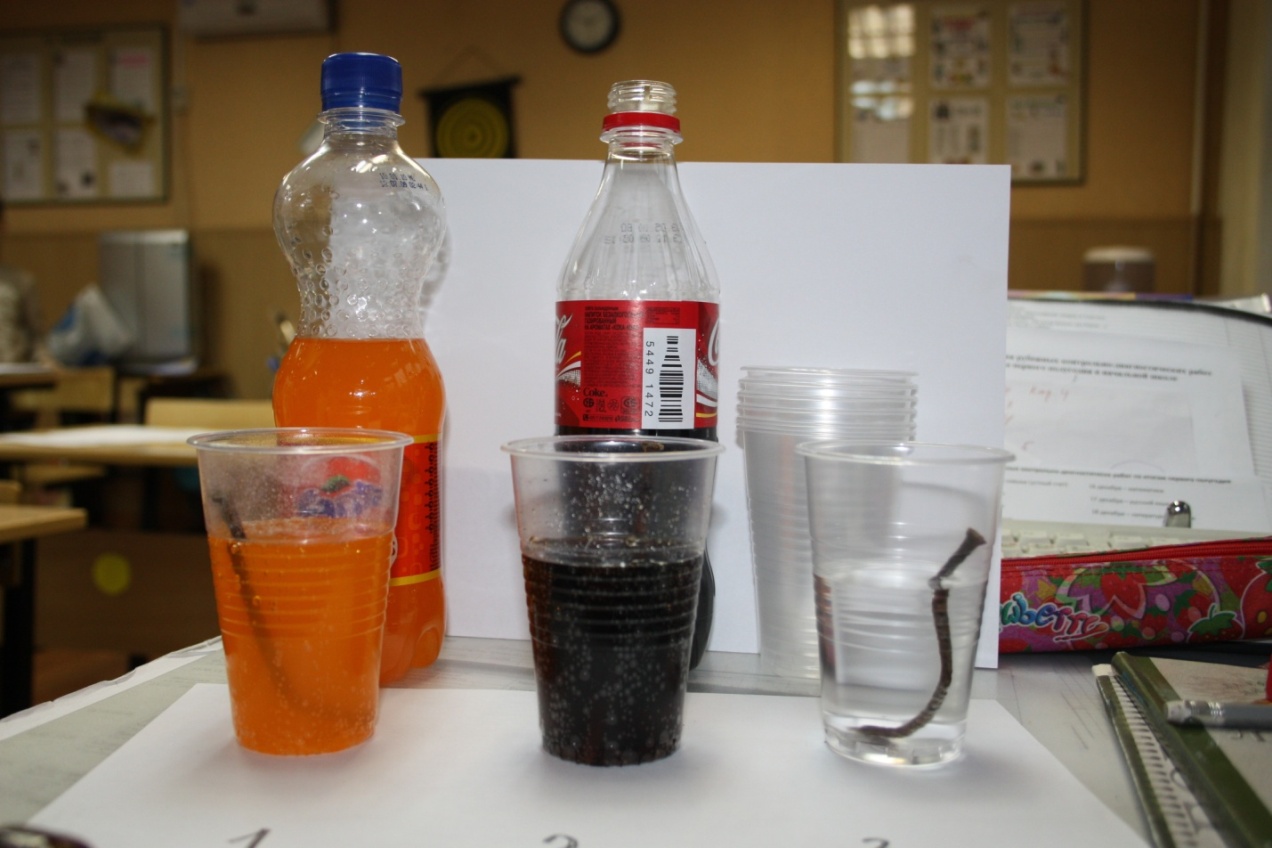
Photo 2. Chicken
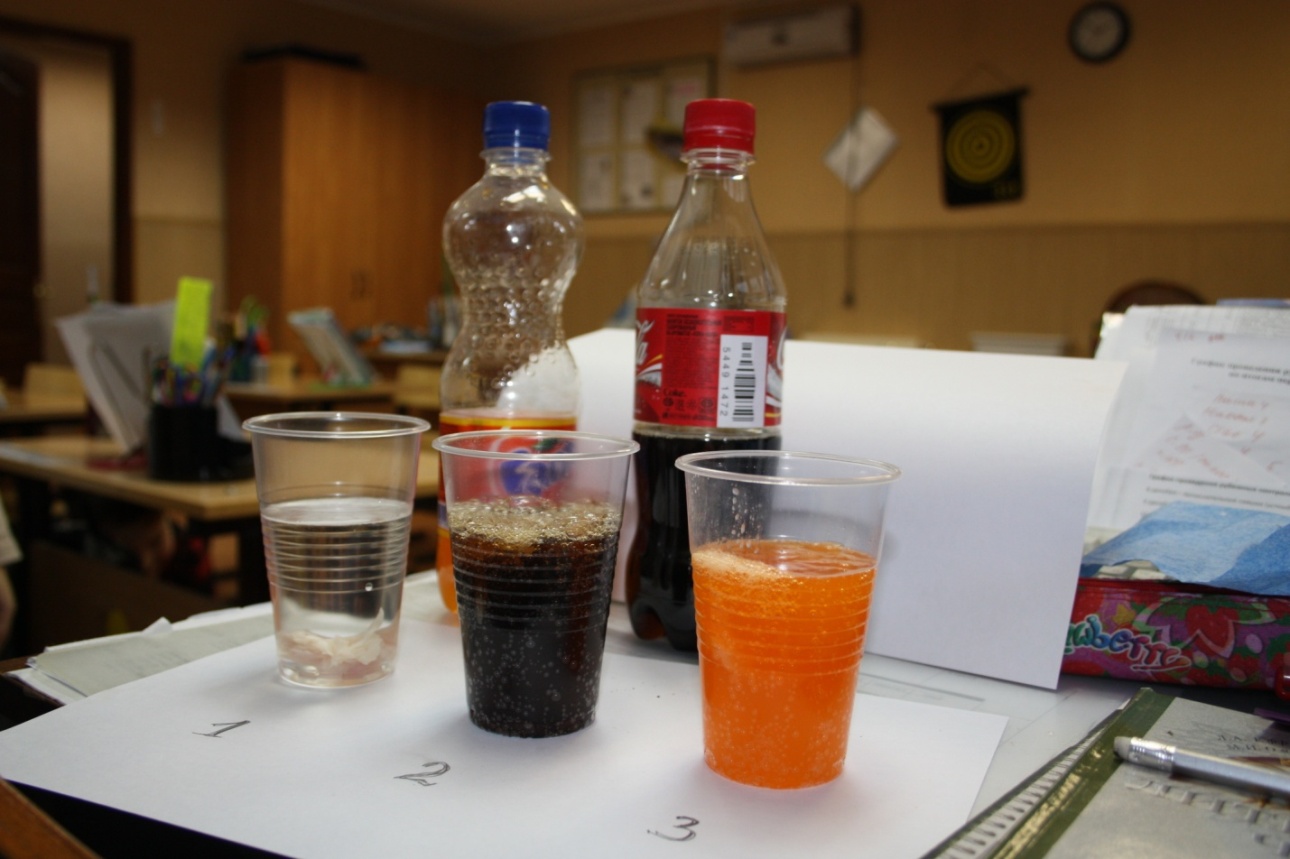
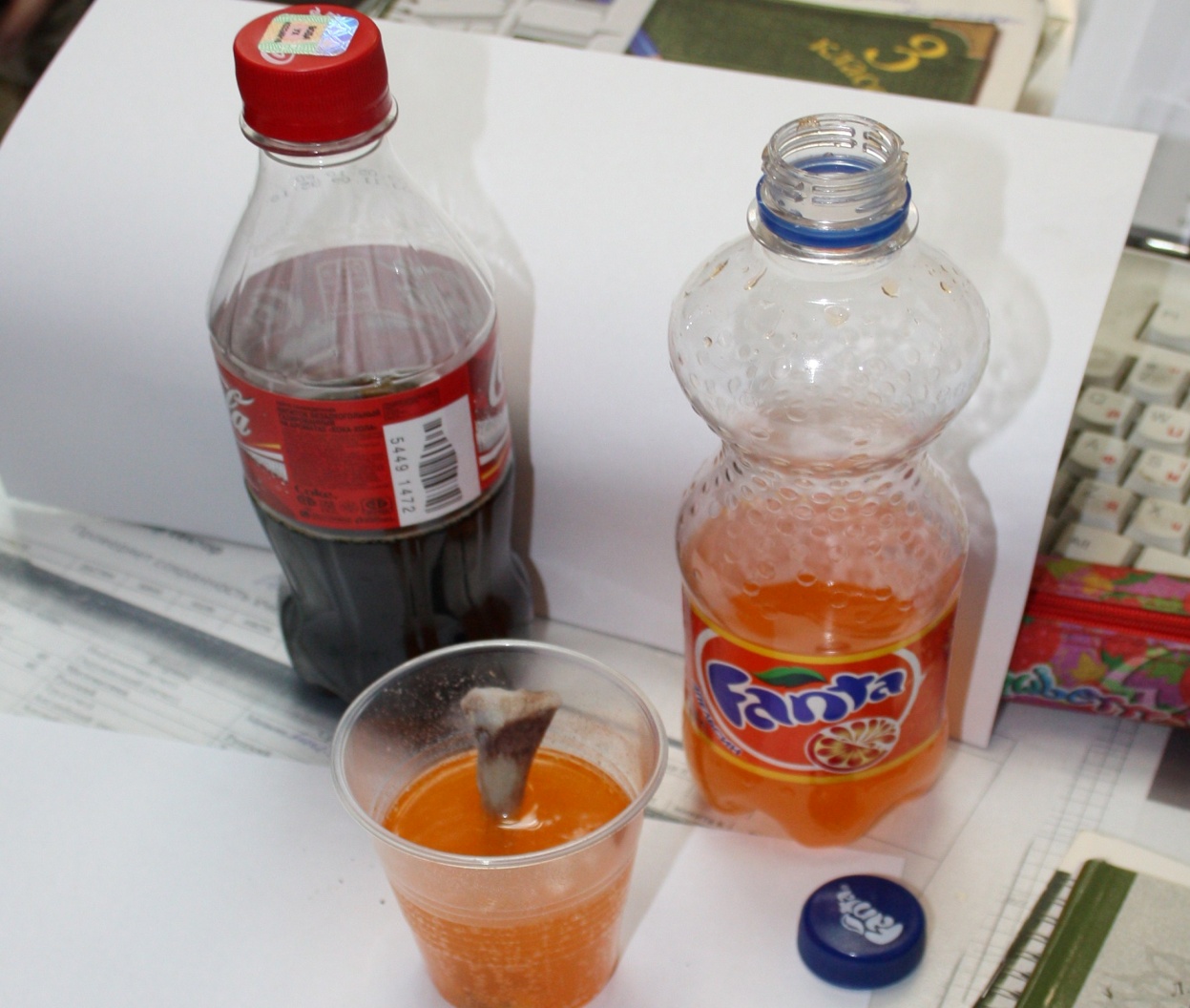
Photo 3. Chicken's bone
From the first minutes we watched , what changes have occurred with our samples .
Chicken, which we filled with carbonated water , and immediately popped start to increase in volume . By the evening of the first day of a piece of meat increased by 2 times .
After 2-3 days, the nail that was filled with carbonated water , and began to clear.
By the end of the experiment ( 3 weeks later ), we obtained the following results.
Piece of meat , which was filled with water and left lying on the bottom of the glass without any visible changes in size and color , while the meat, which was flooded with carbonated water , it became loose , painted in orange and brown colors and putrid odor spread .
Photo 4. Chicken
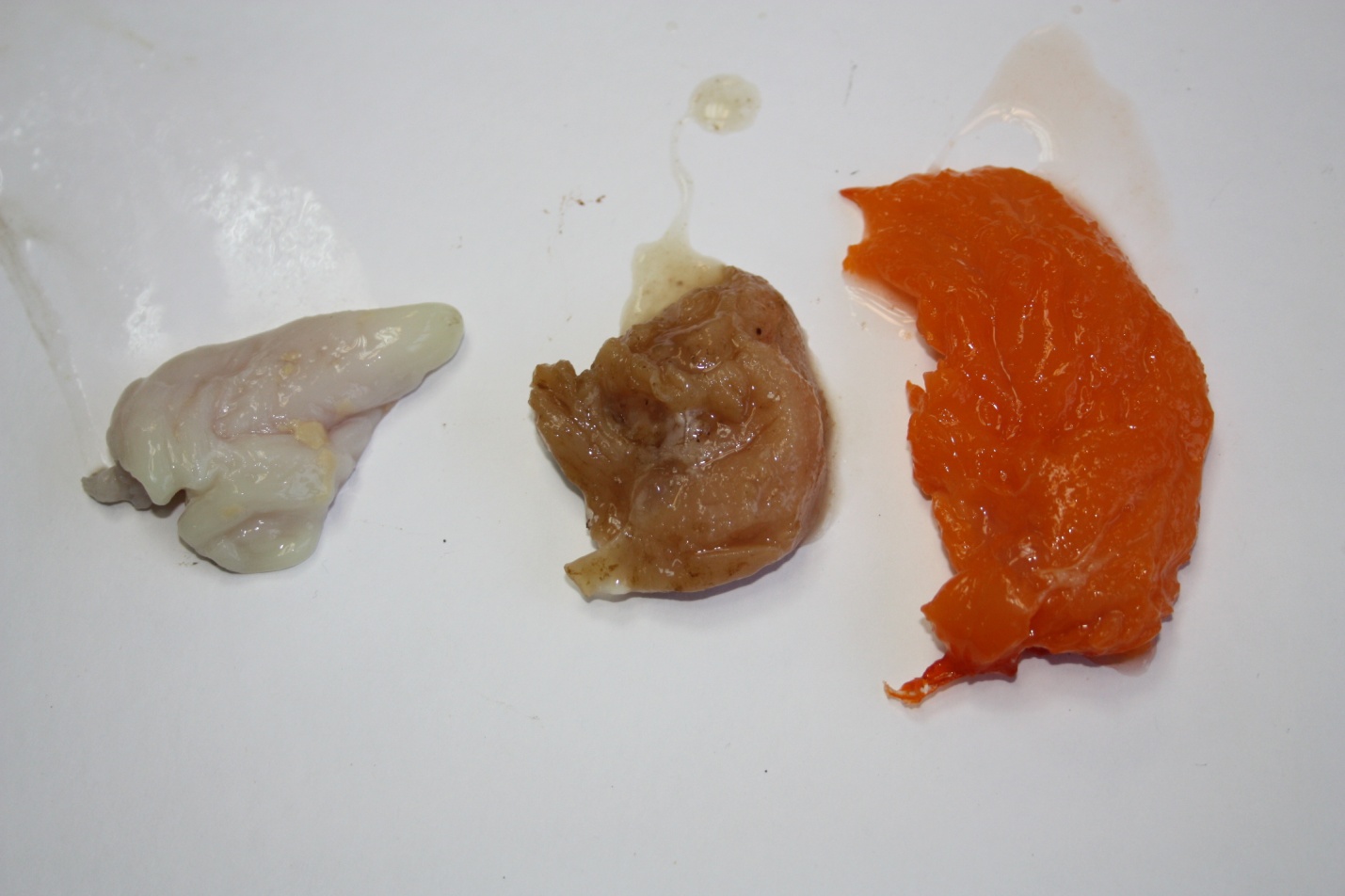
Chicken's bone, flooded with water remained unchanged, and the bone that was floating in soda became colored, and most surprising - it has become soft.
Photo 5. Chicken's bone
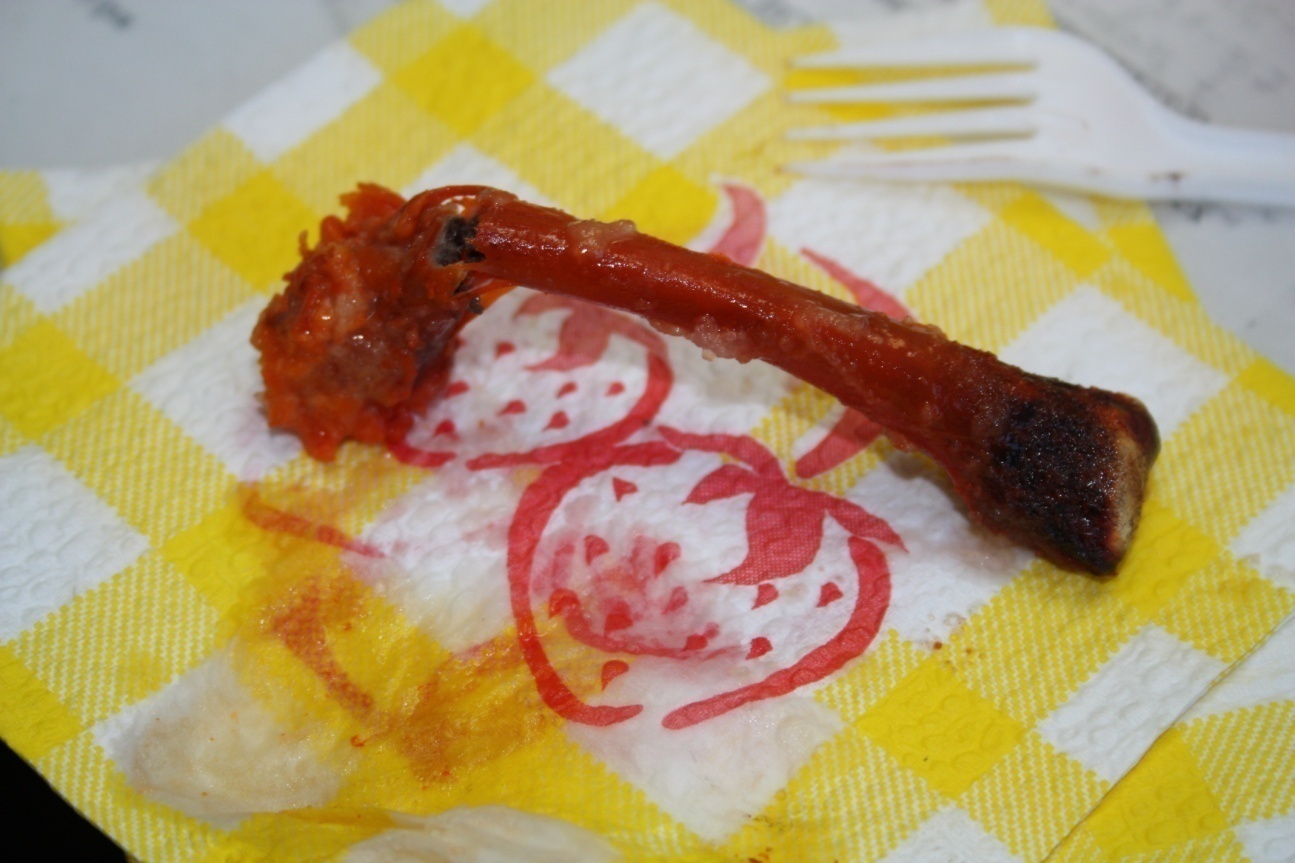
Nail, which was filled with carbonated water, has become almost clean.
Photo 6. Nail (left - out of the water, right - of soda)
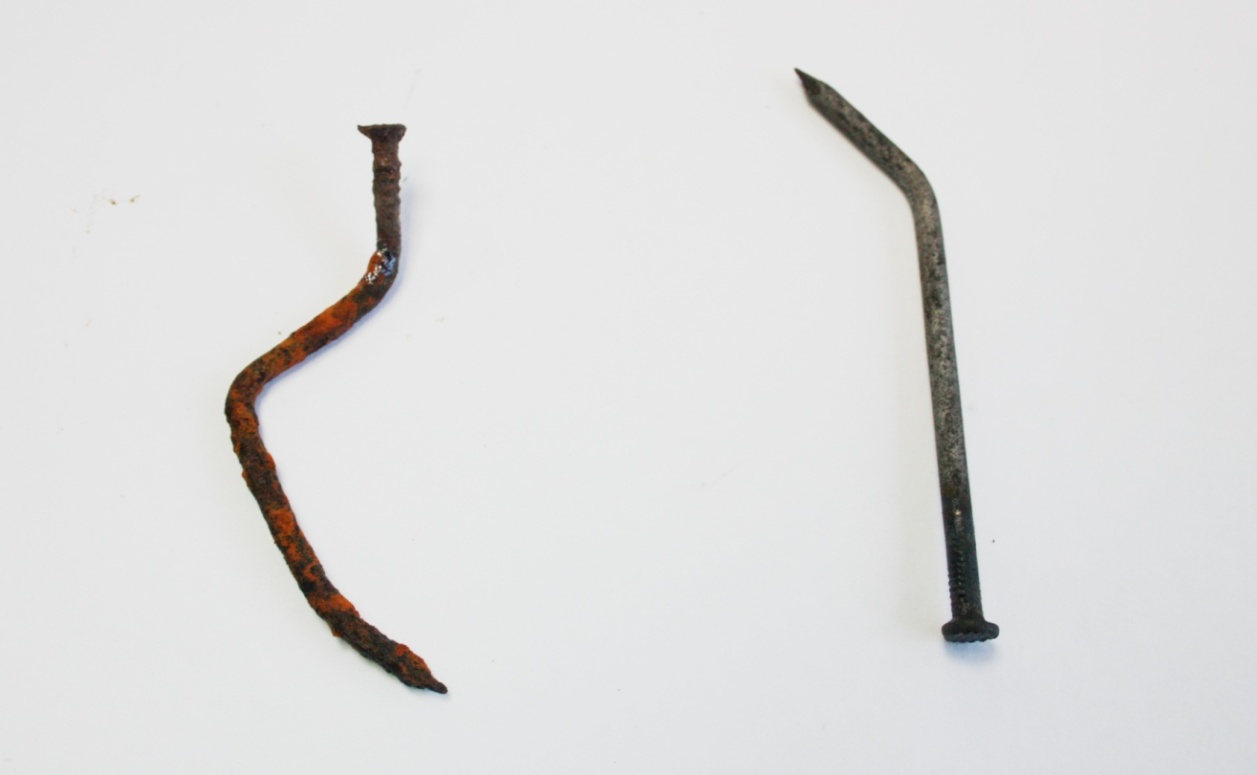
And on the walls of the cup with soda water was muddy sediment from dyes added to these waters.
Photo 7. Sediment at the bottom of the cup after "Phantom"
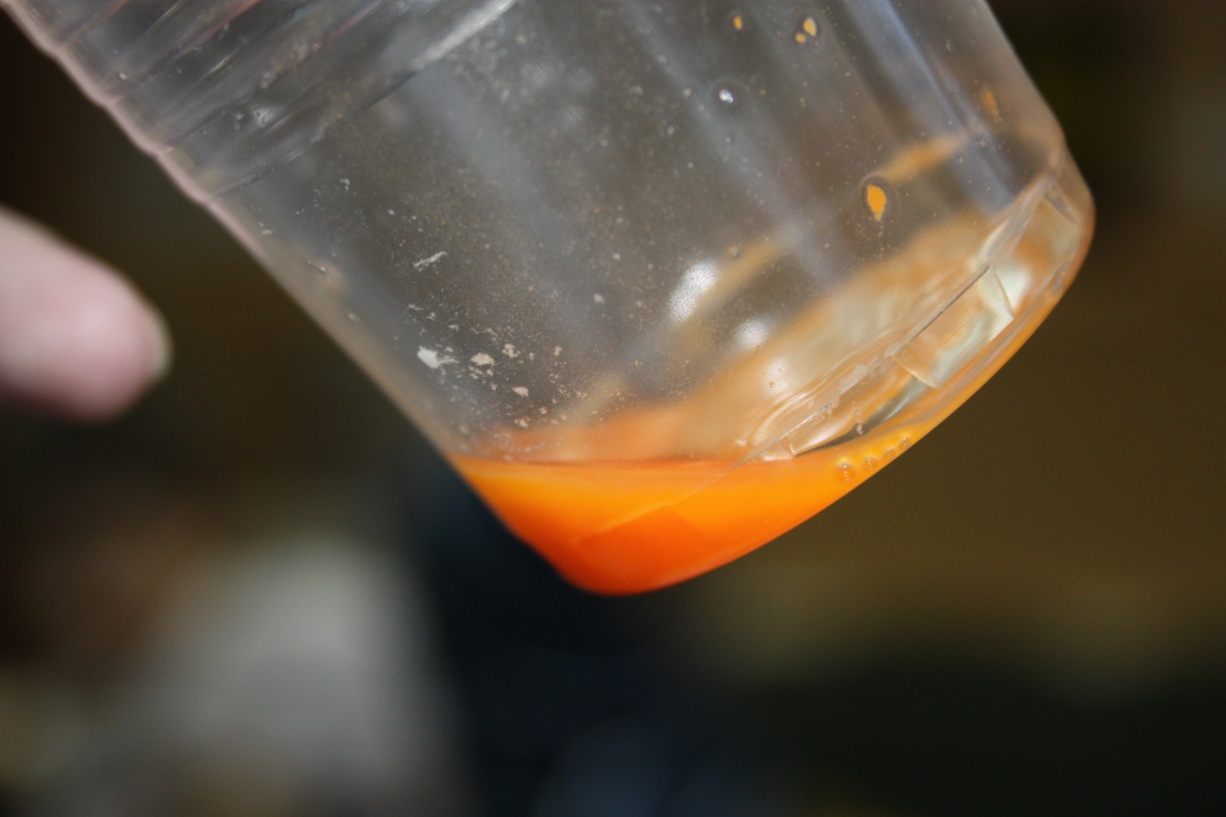
Thus, we made the following conclusion for myself - if soda was able to change as the test samples, then, what a destructive force it is for our body. After all, chicken meat and bone can be exactly correlated with our internal organs and bones. And if a soda can clean rust from such a strong iron objects, then what happens to our bodies, how much he is exhausted under the influence of these drinks.
2.2 Experiments with Coca-cola and humbug
1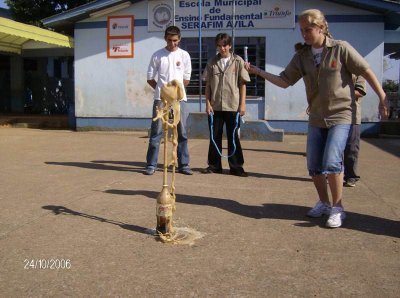 .
Make an experiment and see how sodas is dangerous.
.
Make an experiment and see how sodas is dangerous.
2. You will need a soda («Coca-cola») and humbug (for example «Mentos»). Just dip the mints into the bottle and see the fountain! Beware, the main thing here to catch rebound! And this reaction can occur in each stomach or in the mouth!
2.2. Experimants with crisps
1. I prepared a «fright potato». I want to check for what chips «home» or «store» save its taste.
1.
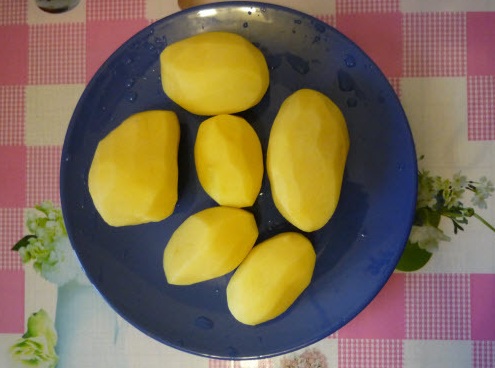
2.

3.

4.
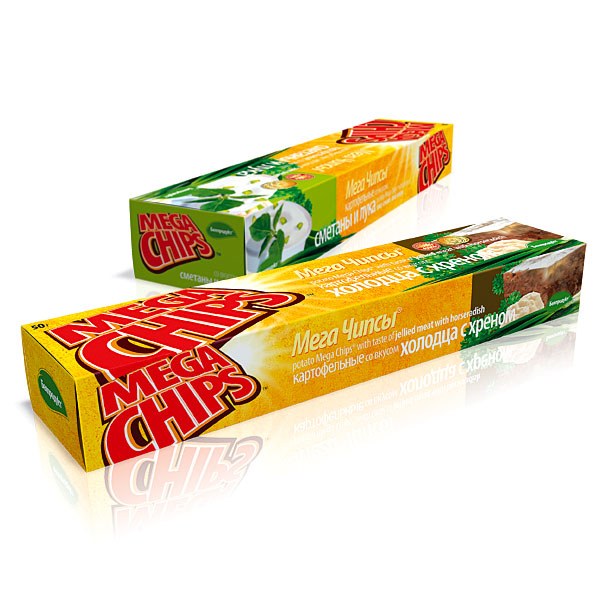 2.
After 2 weeks chips prepared at home, covered with mold, and
«store» remained the same.
2.
After 2 weeks chips prepared at home, covered with mold, and
«store» remained the same.
Conclusion: «store» chips consist of preservatives. thanks for that period of storage increases.
3.Comparative analysis of the quick menu and balanced diet for one day.Breakfast
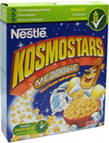
Portion of cornflakes " Hrutka " or chocolate balls ( Stars ) " Kosmostar " with milk , a cup of instant coffee with sugar and cream ( 300-400 calories) .
Minus . Most cereals contain too much sugar : at least three to four teaspoons of harmful saturated fats - a third of the allowable daily allowance and some fiber - only seven to eight percent of the daily requirement . At this dry matter breakfast contains up to 55 % sugar and 2.1 % salt . Sugar is much more than fried donuts that many are deterred , and salt , probably more than in seawater ! But children excess salt and sugar can seriously harm .
LunchCottage cheese or yogurt
(150-200 calories )
Minus. For many fruit supplement replaces real fresh fruit, which must be present in the diet necessary. Also , almost all dairy desserts contain no preservatives and again, bring a hefty dose of sugar in your daily menu . Also , yoghurt products containing fragrances or chemical dyes (this is also indicated on the label ) , it is better not to give children . Chemical additives can badly affect on his health. The only plus : dairy products contain calcium and useful for gastrointestinal bacteria.
Dinner
Minus. No fresh vegetables, very low - in comparison with natural products - the content of vitamins and minerals , a lot of preservatives and flavor enhancers that can trigger allergic reactions , gastritis and ulcers . Typically, the high salt content and fat. In soda - a lot of sugar , flavor enhancers , dyes.
NoshToo many calories for the second half of the day ; much salt , sugar , unhealthy fats, flavors and spices.
Supper
Again preservatives and amplifiers, a lot of fat in cooked meat products , the lack of vegetables and fiber, virtually no vitamins . Generally , too "heavy" meal for the body, which is preparing to sleep. To reduce the cost of technology , these products are usually made from dried at high temperature materials , and sometimes - and all of surrogacy - starch ( not necessarily potato ) , with the addition of various artificial food additives that make the resulting "potato " in yellow , with an appetizing smell . In this case, we can talk about the hazards of the product .
Mayonnaise contains a huge amount of preservatives and stabilizers. A fat evenly cover the inner walls of your blood vessels. Among the harmful products applies ketchup , various sauces and dressings, in a wide range shown on the shelves of our stores.
"Healthy Menu" on a typical day
Breakfast
Porridge with milk-110 calories (vitamins A, B, E, PP).
Tea with milk -102 calories (tea with milk is very useful for the brain).
Lunch
Banana - 68 calories (vitamin E).
Glass of juice - 54 calories (vitamin A).
Dinner
Soup-250 calories (soup is very rich of vitamins and fiber).
Mashed potatoes-119 calories.
Cranberry jelly-62 calories (cranberry jelly improves visual acuity) .
Supper
 "Vinigret"-140
calories.
"Vinigret"-140
calories.
Plus- vegetables are rich of the mineral properties. They contain vitamins , minerals and other substances.
Conclusion: In contrast to the menu " fast food " , " Healthy Menu" contains no more than 1,500 calories . (no more than the daily requirement ) , contains many beneficial for the body of vitamins , minerals, trace elements . And it is very nutritious.
Conclusion
Summing up the work , it should be emphasized that in recent years , physicians ascertain a significant deterioration in the health of children and adolescents. And such a high fatigue and depression so many children have not ever mentioned . All this ( together with other factors ) - a consequence of the neglect of nutrition in the family, in school, in society at large . This situation can be corrected only by the transition to a proper healthy diet and a healthy lifestyle . It is important that the right attitude to nutrition and healthy lifestyles formed from early childhood in the family, at school.
If all the money that is spent on aggressive advertising of beer and energy drinks to spend on the promotion of healthy nutrition and a healthy lifestyle , we would be the healthiest nation - we have everything needed for this . A healthy diet - it's just natural and healthy foods that ate our ancestors .
Modern society relies heavily on fast food . However , we are not able to understand the fact that there are certain problems that are associated with the consumption of fast food. Problems that arise because of these products is mainly related to health.
Fast food is a concept that originated in the 19th century as a response to the growing demand for food . The concept of fast food is also determined by the term itself. "Fast" foods that can be prepared quickly. Cooking fast food mainly involves the use of cooking methods that allow the chef or cook to finish the cooking process in the shortest possible time . Advances in the field of food processing industry to reduce costs and improve the taste of food . In this fast food is the choice of a large number of people around the world .
Health problems caused by fast food include obesity , diabetes and hypertension. Many of us tend to often eat such foods that are high in fat and calories. This food is not enough large amount of fiber and it hard to digest. Body is unable to digest a heavy meal , which leads to the deposition of fat in the tissues.
Recently, networks of fast food began to appear healthy foods . Many products now have a high content of salads and vegetables and made with sauces and pickles , which are rich in vitamins . You can find foods that are low in fat and whole wheat bread . There are already , even restaurants with vegetarian food.
We have a choice ! So , it all depends on our understanding that there is proper nutrition and the pursuit of a healthy life.
In preparing this research, we realized that we
are responsible for their own health. We chose a healthy diet and a
healthy lifestyle !
VIII. List of literature.
-
www.allwomens.ru/
-
www.molomo.ru/
-
oagb.ru/
-
www.perfectlady.ru/
-
www.pravda.ru/
-
www.subway.ru/
-
www.stardogs.ru/
-
ru.wikipedia.org/
-
vkusnopoem.ru/
-
www.answers.com/to/prepod/_bloks/pic/fast-food
-
www.chudopredki.ru
-
www.youngwomenshealth.org
-
Bill Sass, «Tips for trimming calories, fat», The Record - Kitchener, Ont, Jun 13, 2005: «The fish burger, deep fried, could have more calories than a quarter-pound beef burger.»
-
An unusual hamburger experiment is part of the University of Minnesota's dietary research annals. Medical bulletin. University of Minnesota. Winter 2008.
-
Mark Pendergrast For God, Country, and Coca-Cola: The Definitive History of the Great American Soft Drink and the Company That Makes It</</font>. - 2 ed. - Basic Books, 2000.
Attachment №1.
1. Do you regularly eat?
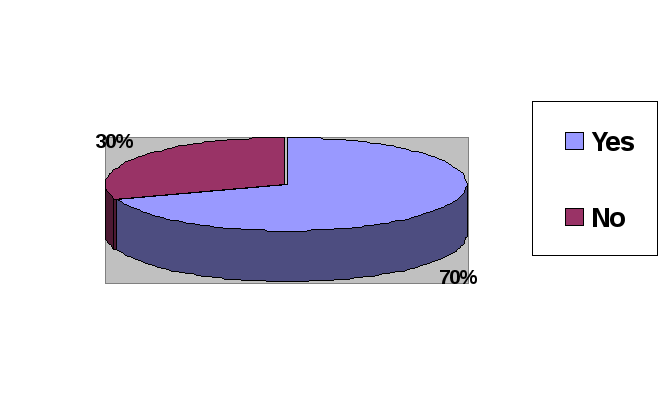
Attachment №2.
2. Do you eat in school cafeteria ?

Attachment №3.
3. Does your mum has enough time to cook lunch and dinner ?
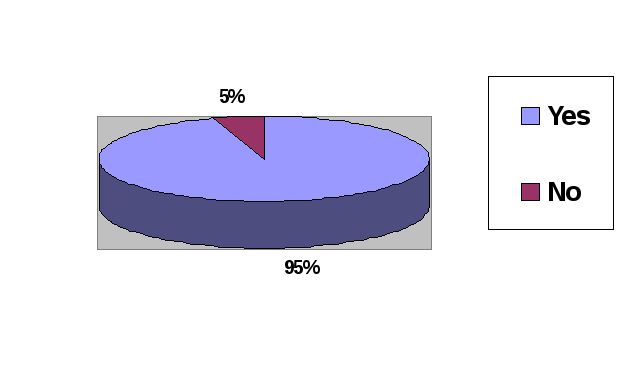
Attachment №4
4. Do you eat crisps?
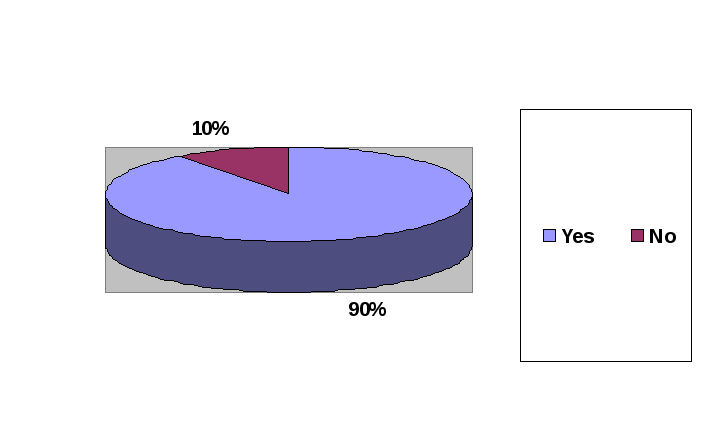
Attachment №5.
5. Do you like to eat hamburgers, hot dogs, sandwiches ?
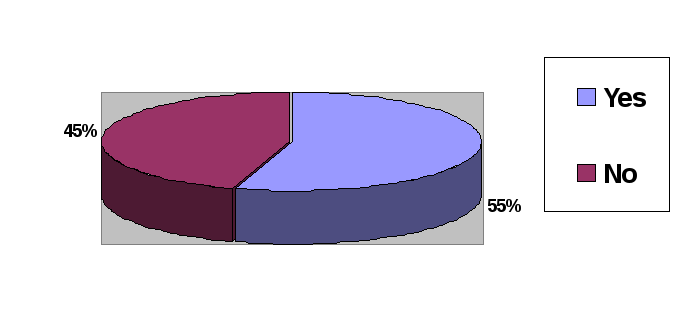
Attachment №6.
6. Which food is a "healthy food" ?Select or offer their own (porridge, sandwich, Fanta, Pepsi, apples, pears , oranges, vegetables, salad, soup, fresh juice, Big Mac).

Attachment №7.
7. You are ready to change your eating habits to stay healthy ?
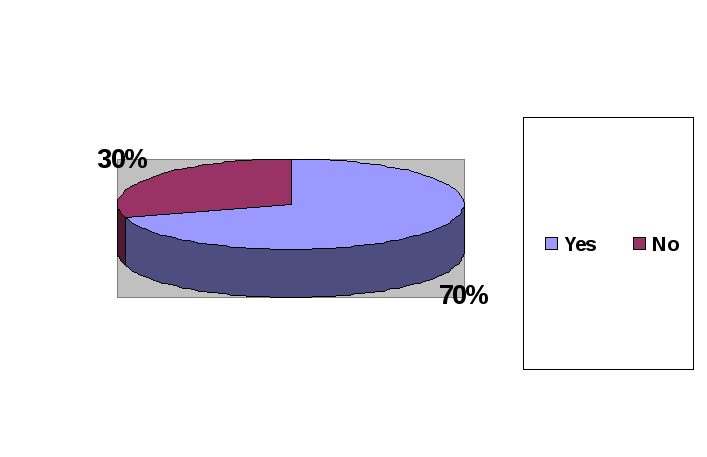
TEST 2
Attachment № 8
1. Do you like crisps , coca-cola , crackers , etc.
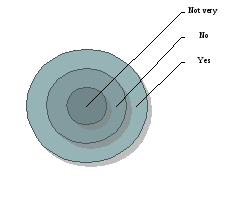
Attachmen №9
2.Do you like to be in McDonalds ?
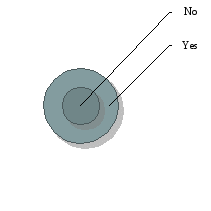 Attachmen
№10
Attachmen
№10
3. How often do you eat crisps, crackers ?
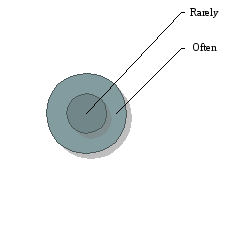
Attachment № 11
4 . How often do you drink coca - cola and carbonated drinks ?
 Attachment № 12
Attachment № 12
5 . Are you aware of the dangers of crisps and fizzy drinks ?

Attachment № 13
6. Do you have a sore stomach after drinking carbonated drinks or chips ?
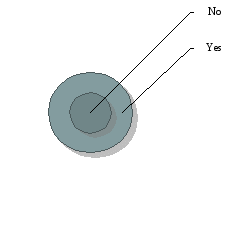 Attachment
№ 14
Attachment
№ 14
7. Do you like vegetables?
